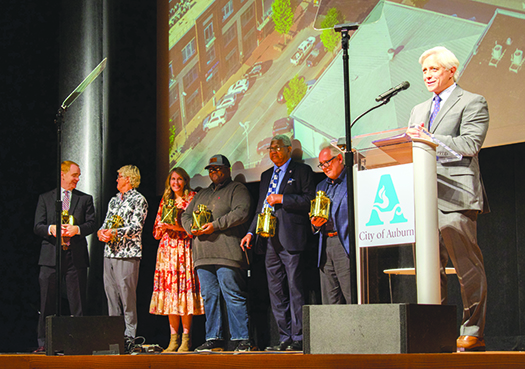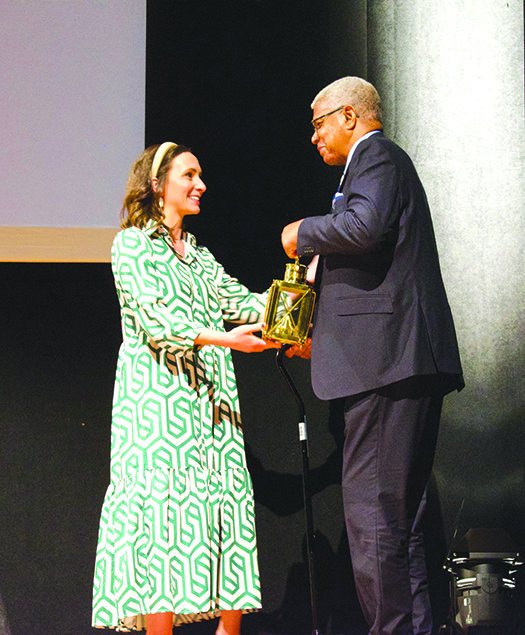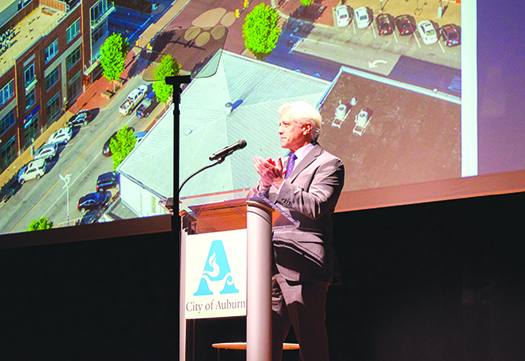BY KENDYL HOLLINGSWORTH
KENDYLH@
OPELIKAOBSERVER.COM
AUBURN —
There are many milestones to celebrate and upgrades to anticipate in coming years, according to Auburn Mayor Ron Anders.
In his fourth annual State of the City address, held Nov. 16 at the Jay and Susie Gogue Performing Arts Center, Anders discussed Auburn’s growth and how the city is working to keep up with progress, while remaining true to its traditional roots.
“As we grow, I believe the things that are essential to Auburn will not be lost,” he said. “Auburn is not a community of buildings or roads, but a community of people.”
Between excellent bond ratings and a new $140 million budget adopted for fiscal years 2023 and 2024, Anders said the city continues to consult citizens as it plans carefully to improve the quality of life for Auburn residents moving forward.
POPULATION AND COMMUNITY ENGAGEMENT
It’s no secret that Auburn is growing. According to Anders, the city is growing by an average of 6.6 people every day. The latest census estimate showed a population of a little over 78,500 people, but today, Anders said that number is closer to 80,000.
“It is easy to think of these newcomers as just numbers, and to maybe feel a little anxious about how quickly our population is increasing,” he said during his address. “I assure you, there is enough Auburn to go around. But I understand the concerns about growth. I drive our streets every day, just like you do. I know it takes more time to get to where you’re going than it used to. While we are continuously thinking about how we can improve traffic flow on our roads and intersections, we also have to recognize the simple math that more people bring more traffic.”
As the population continues to rise, Anders assured residents that the city is working and planning daily to manage that growth well. Some of the tools in Auburn’s toolbox include a program that helps predict where growth will occur, as well as a master street plan and optimal growth boundary to help guide the city’s decisions on infrastructure and annexation.
Citizens are also becoming more involved. Nearly 20 graduated this year from Auburn’s first Citizens’ Academy class, which aimed to give participants a behind-the-scenes look at how the city’s 19 departments operate.
“These programs are among the many steps the city has made to demonstrate transparency and to engage the public in what we do and how we do it,” Anders said, noting that citizen input and participation is “crucial to Auburn’s continued success.”
The city also launched its first Neighborhood Conference this year. Similar to the Citizens’ Academy, the goal of the conference was to bring city staff, residents and neighborhood groups together to learn how they can work in tandem.
The city of Auburn is also working to increase efforts to keep residents informed, Anders said. Some of those efforts include new, dedicated social medial channels for Public Safety, Parks and Recreation and the Auburn Public Library. The Auburn Public Safety and FixIt apps also seek to streamline communication between Auburn residents and city departments.
Anders also encouraged residents to stay informed by watching city council meetings, subscribing to the city’s e Notifier, reading the Open Line newsletter and listening to the Open Line podcast. He said the city is also working on an upgraded online news page.
“It’s important to us to make information available to you, where you are,” Anders said. “If there’s a way you’d prefer to hear from us that we’re not already providing, I know our staff would love to hear from you.”
SCHOOLS AND BUSINESSES
Anders spotlighted the city’s “outstanding public and private schools,” noting its high rankings on state and national lists, award-winning teachers and high rates of graduation and scholarship awards.
In addition, Anders said J.F. Drake Middle School has undergone “significant improvements,” including a new cafeteria, fine arts building and academic building, with more improvements set for existing buildings. A new gymnasium is almost complete at East Samford School, and nearly 170 new parking spaces were recently added at Auburn High School.
Next year, the city will also welcome Woodland Pines Elementary School on Farmville Road, serving students from kindergarten through second grade. It will be the city’s 10th elementary school.
The city is also in the design stage of a second high school to be added off of North Donahue Drive.
“I know immense thought is being put into every detail,” Anders said.
Auburn University is also a major partner of the city’s, Anders added. With its students making up nearly 40% of the city’s population, he said it’s a priority to reach the student body and maintain a connection with them. SGA has plans to launch a video series on Instagram and TikTok to keep students informed on what’s happening in the city — whether at council meetings or around town.
“I am hopeful to see more students civically engaged, and I am committed to the ongoing dialogue we have with the Student Government Association,” Anders said.
The university is also a partner through Auburn Research Park, East Alabama Health, the Gogue Performing Arts Center and collaborations with the city’s Public Safety entities.
The business scene is also flourishing, according to Anders. A few major businesses added to the city include AUBix datacenter, Buc-ee’s, HomeGoods and Publix in downtown Auburn (a $20 million investment), with the downtown Target and a couple of hotels on the way.
The Auburn Chamber of Commerce also celebrated 57 new local businesses with ribbon cuttings, and Anders said the local restaurant scene is also booming with the addition of the Tony and Libba Rane Culinary Science Center and several restaurants. But perhaps it was the construction of Exit 50 that gave Auburn its most significant boost as of late.
“Thanks in large part to the investment of our federal delegation over the years, we can trace nearly 4,000 jobs, $1.7 billion in investment and $200 million in annual wages back to the construction of Exit 50,” Anders said.
Several other infrastructure projects have also played a major role in turning Auburn into a destination location.
INFRASTRUCTURE
Infrastructure has seen some key improvements in the last few years, with more improvements on the way, according to Anders. Some of the most significant changes have been made to Opelika Road.
“It was a big project on a roadway we inherited from the state, and some things just did not go as planned,” Anders said, noting complications that stemmed from weather, the pandemic and supply issues, as well as surprises like a hidden layer of concrete.
The road has come a long way since 2011, when the city identified it as a key commercial corridor that needed to be redeveloped. The Renew Opelika Road plan came a little later and entailed new zoning regulations and an incentive plan for sales tax-generated businesses that committed to Opelika Road, as well as funding for major intersection and infrastructure improvements.
“Since the plan’s inception, we’ve seen upgrades to major intersections along the corridor,” Anders noted. “We’ve seen cosmetic changes, from adding landscape medians to getting rid of those old ditches that used to surround Auburn Mall. Changes in zoning regulations have helped transform the road from a state highway into an urbanized pedestrian-, bicycle- and business-friendly destination where people live, shop and eat.”
According to Anders, the city has spent about $7.6 million so far on infrastructure, and more is budgeted for further improvements. Businesses have also invested more than $97 million into the Opelika Road corridor since 2011, and sales tax and related revenues for the area are expected to increase by $9.7 million this fiscal year, Anders said.
Other infrastructure projects include the intersection of Cox and Wire roads, which saw the installation of a roundabout to combat traffic congestion and serious wrecks, and the construction of a new road that will connect Richland Road to Martin Luther King Drive.
“The council was proud to dedicate this road earlier this year to Auburn Police Officer William Buechner, whose life was taken in the line of duty,” Anders said. “We ought to never forget this great man or his name, and with the Will Buechner Parkway, we never will.”
CITY AMENITIES
Both citizens and city staff are enjoying new and upgraded amenities, with more to look forward to soon.
“We are at a milestone in implementation of our Parks, Recreation and Cultural Master Plan as we complete the first five-year phase of projects and begin budgeting for the next round,” Anders said. The plan, adopted in 2018, spells out a 20-year plan to improve these facilities and related programming.
One of the most notable projects that came out of the master plan, Anders said, was the Town Creek Inclusive Playground, which opened earlier this year. The park is 90% accessible, much higher than the 15% required by ADA guidelines.
“This bright and beautiful amenity sets us apart from other communities because its playful, inviting environment has something for every ability and age,” Anders explained. “… We’re proud to see people enjoy this amazing amenity for people of all abilities to play together.”
The Auburn Soccer Complex is also seeing an $8.6 million expansion. Upon completion, Anders said hundreds of young players and their families will enjoy three additional synthetic-turf, outdoor, multisport fields and a multipurpose building with indoor courts, as well as more restrooms and parking. The entrance will also be enhanced, and a roundabout will be installed.
Anders also touched on the Lake Wilmore Project, a recreation complex that will be constructed in two phases to include a community center and expanded outdoor offerings.
“These additions will give us more space to hold practice and games for our surging athletic programs, like our youth basketball league with more than 1,000 players,” Anders said.
Before the end of the year, work will begin on the expansion of the Jan Dempsey Community Arts Center, which will include a new gallery, a dance studio, new programming space, relocation of the ceramics studio and more. Anders said the improvements will also free up space at the Dean Road Recreation Center for its therapeutic programs.
“These programs, specifically designed for Auburn’s residents with special needs, are a valuable asset to our community and have needed room to grow for years,” he said.
For city staff, forthcoming changes include a Public Safety training center, located on the former rest area site on Highway 280 across from North College Street, and a new Environmental Services and Public Works facility.
The training center will include a 12,000-square-foot classroom building and drill tower, as well as a search-and-rescue maze, burn building and drafting pit.
Anders said the new Environmental Services and Public Works facility will feature more room to store materials and be better prepared to respond during storms, and it will eventually house a nursery onsite to grow trees and plants that will be used in the city’s right-of-ways. The Auburn Recycling Center, currently located off North Donahue, will also move across the street to take the place currently used by the city’s fleet services.
NORTH AUBURN
As the aforementioned facilities relocate, Anders said their old facilities will be demolished to make way for major improvements and additions to the Boykin Community Center campus. Some of these will include a branch library, cultural resource center and a recreation center featuring a splash pad.
MLK Drive will also see a major streetscape project, set to begin next year.
“Much like Opelika Road, this corridor was identified as a gateway to our community and prioritized in the Northwest Auburn Neighborhood Plan,” Anders said. “Resident input included a consensus that the corridor could benefit from infrastructure improvements that not only make the street more attractive, but help with traffic flow.”
In addition to enhancing the streetscape along MLK between Shug Jordan Parkway and Donahue Drive, plans include adding a 10-foot sidewalk, pedestrian lighting, landscaping and medians, a new water vane and storm and sanitary extensions.
Fire Station No. 6, located in north Auburn, is also in full operation now, Anders said.
Anders recounted the city’s history of investments and improvements made to the northwest Auburn area dating back to the 1980s. Since 2004, Auburn has invested more than $22 million in northwest Auburn enhancements; with the MLK Drive project and Boykin expansion, that total investment is set to reach about $55 million.
“There are a lot of good things going on here in your hometown,” he said. “Even as it evolves, Auburn will always be the Loveliest Village, orange-and-blue, an educational beacon and so much more. Auburn is innovation and progress and forward thinking, and yet, it is still tradition and cherished memories.
“We can veer off the path by believing these ideas are mutually exclusive. We can be innovation and tradition. … I have confidence that we will continue moving into a bright future.”

Stanley Sistrunk; Auburn Mayor Ron Anders.
LAMPLIGHTER AWARDS
In his address, Anders attributed much of Auburn’s growth and successes to the contributions of community members and departments. He capped off the event by honoring six of these citizens with Lamplighter Awards.

This year’s honorees include Mark Armstrong, executive director of academic partnerships at Auburn University; Keely Beasecker, founder and owner of Niffer’s; Shannon Brandt, longtime educator for Auburn City Schools; Michael Floyd, Auburn University student, vice president of The Jungle and writer for The Plainsman; Capt. John Lockhart, retired from the Auburn Police Department; and Stanley Sistrunk, owner of The Flower Store.
None of the honorees knew they would receive the award, leading to genuine surprise from each as their names were called.
Anders said the Lamplighter Awards were named for a story from Robert Louis Stevenson’s childhood in which he saw a lamplighter “punching holes in the darkness” in his neighborhood. The recipients of these awards, Anders said, were responsible for the same — illuminating Auburn through their hearts and service to the community.
“As I tell people, Auburn’s not a perfect community, but it’s a really great community,” Anders said in closing. “ I hope you’ll find your way to get involved here in the future and help us continue to make Auburn a very special place.”


